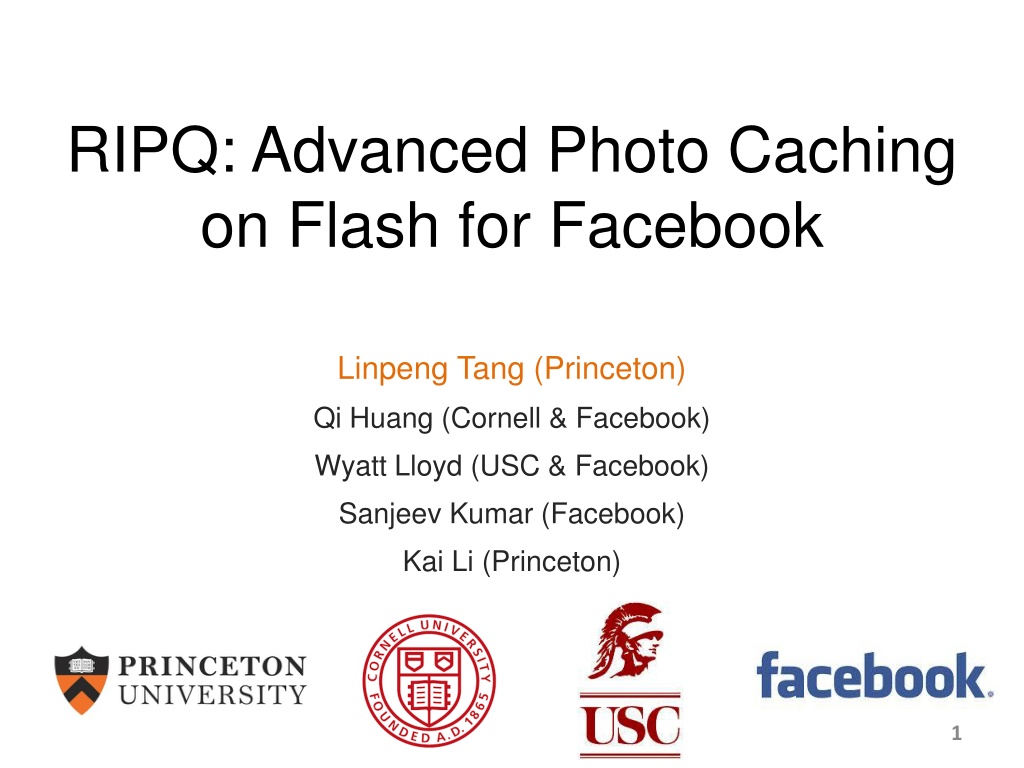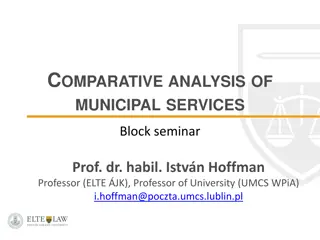
Advanced Photo Caching Strategies for Facebook Optimization
Explore the innovative solutions presented by RIPQ researchers from top universities and Facebook for enhancing photo caching on Flash to reduce backend IOs and backbone traffic. Learn about advanced caching algorithms, priority queues, and practical implementations to optimize photo serving stack performance efficiently.
Download Presentation

Please find below an Image/Link to download the presentation.
The content on the website is provided AS IS for your information and personal use only. It may not be sold, licensed, or shared on other websites without obtaining consent from the author. Download presentation by click this link. If you encounter any issues during the download, it is possible that the publisher has removed the file from their server.
E N D
Presentation Transcript
RIPQ: Advanced Photo Caching on Flash for Facebook Linpeng Tang (Princeton) Qi Huang (Cornell & Facebook) Wyatt Lloyd (USC & Facebook) Sanjeev Kumar (Facebook) Kai Li (Princeton) 1
2 Billion* Photos Shared Daily Photo Serving Stack Storage Backend 2 2 * Facebook 2014 Q4 Report
Photo Serving Stack Photo Caches Close to users Reduce backbone traffic Edge Cache Flash Co-located with backend Reduce backend IO Origin Cache Storage Backend 3
An Analysis of Facebook Photo Caching [Huang et al. SOSP 13] Photo Serving Stack Advanced caching algorithms help! Edge Cache Segmented LRU-3: 10% less backbone traffic Flash Origin Cache Greedy-Dual-Size-Frequency-3: 23% fewer backend IOs Storage Backend 4
Photo Serving Stack In Practice Edge Cache FIFO was still used Flash No known way to implement advanced algorithms efficiently Origin Cache Storage Backend 5
Theory Practice Advanced caching helps: 23% fewer backend IOs 10% less backbone traffic Difficult to implement on flash: FIFO still used Restricted Insertion Priority Queue: efficiently implement advanced caching algorithms on flash 6
Outline Why are advanced caching algorithms difficult to implement on flash efficiently? How RIPQ solves this problem? Why use priority queue? How to efficiently implement one on flash? Evaluation 10% less backbone traffic 23% fewer backend IOs 7
Outline Why are advanced caching algorithms difficult to implement on flash efficiently? Write pattern of FIFO and LRU How RIPQ solves this problem? Why use priority queue? How to efficiently implement one on flash? Evaluation 10% less backbone traffic 23% fewer backend IOs 8
FIFO Does Sequential Writes Cache space of FIFO Head Tail 9
FIFO Does Sequential Writes Cache space of FIFO Head Tail Miss 10
FIFO Does Sequential Writes Cache space of FIFO Head Tail Hit 11
FIFO Does Sequential Writes Cache space of FIFO Head Tail Evicted No random writes needed for FIFO 12
LRU Needs Random Writes Cache space of LRU Head Tail Hit Locations on flash Locations in LRU queue 13
LRU Needs Random Writes Cache space of LRU Head Tail Non-contiguous on flash Random writes needed to reuse space 14
Why Care About Random Writes? Write-heavy workload Long tail access pattern, moderate hit ratio Each miss triggers a write to cache Small random writes are harmful for flash e.g. Min et al. FAST 12 High write amplification Low write throughput Short device lifetime 15
What write size do we need? Large writes High write throughput at high utilization 16~32MiB in Min et al. FAST 2012 What s the trend since then? Random writes tested for 3 modern devices 128~512MiB needed now 100MiB+ writes needed for efficiency 16
Outline Why are advanced caching algorithms difficult to implement on flash efficiently? How RIPQ solves this problem? Evaluation 17
RIPQ Architecture (Restricted Insertion Priority Queue) Advanced Caching Policy (SLRU, GDSF ) Priority Queue API Caching algorithms approximated as well Approximate Priority Queue Flash-friendly Workloads Efficient caching on flash RAM Flash RIPQ 18
RIPQ Architecture (Restricted Insertion Priority Queue) Advanced Caching Policy (SLRU, GDSF ) Priority Queue API Restricted insertion Section merge/split Large writes Lazy updates Approximate Priority Queue Flash-friendly Workloads RAM Flash RIPQ 19
Priority Queue API No single best caching policy Segmented LRU [Karedla 94] Reduce both backend IO and backbone traffic SLRU-3: best algorithm for Edge so far Greedy-Dual-Size-Frequency [Cherkasova 98] Favor small objects Further reduces backend IO GDSF-3: best algorithm for Origin so far 20
Segmented LRU Concatenation of K LRU caches Cache space of SLRU-3 L1 L3 L2 Tail Head Miss 21
Segmented LRU Concatenation of K LRU caches Cache space of SLRU-3 L1 L3 L2 Head Tail Miss 22
Segmented LRU Concatenation of K LRU caches Cache space of SLRU-3 L1 L3 L2 Head Tail Hit 23
Segmented LRU Concatenation of K LRU caches Cache space of SLRU-3 L1 L3 L2 Head Tail Hit again 24
Greedy-Dual-Size-Frequency Favoring small objects Cache space of GDSF-3 Head Tail 25
Greedy-Dual-Size-Frequency Favoring small objects Cache space of GDSF-3 Head Tail Miss 26
Greedy-Dual-Size-Frequency Favoring small objects Cache space of GDSF-3 Head Tail Miss 27
Greedy-Dual-Size-Frequency Favoring small objects Cache space of GDSF-3 Head Tail Write workload more random than LRU Operations similar to priority queue 28
Relative Priority Queue for Advanced Caching Algorithms Cache space 1.0 0.0 p Tail Head Miss object: insert(x, p) 29
Relative Priority Queue for Advanced Caching Algorithms Cache space 1.0 0.0 p Tail Head Hit object: increase(x, p ) 30
Relative Priority Queue for Advanced Caching Algorithms Cache space 1.0 0.0 Tail Head Implicit demotion on insert/increase: Object with lower priorities moves towards the tail 31
Relative Priority Queue for Advanced Caching Algorithms Cache space 1.0 0.0 Tail Head Evicted Evict from queue tail Relative priority queue captures the dynamics of many caching algorithms! 32
RIPQ Design: Large Writes Need to buffer object writes (10s KiB) into block writes Once written, blocks are immutable! 256MiB block size, 90% utilization Large caching capacity High write throughput 33
RIPQ Design: Restricted Insertion Points Exact priority queue Insert to any block in the queue Each block needs a separate buffer Whole flash space buffered in RAM! 34
RIPQ Design: Restricted Insertion Points Solution: restricted insertion points 35
Section is Unit for Insertion 1 .. 0.6 0.35 .. 0 0.6 .. 0.35 Section Section Section Tail Head Sealed block on flash Active block with RAM buffer Each section has one insertion point 36
Section is Unit for Insertion 1 .. 0.6 1 .. 0.62 0.35 .. 0 0.33 .. 0 0.6 .. 0.35 0.62 .. 0.33 Section Section Section Tail Head +1 insert(x, 0.55) Insert procedure Find corresponding section Copy data into active block Updating section priority range 37
Section is Unit for Insertion 1 .. 0.62 0.33 .. 0 0.62 .. 0.33 Section Section Section Tail Head Sealed block on flash Active block with RAM buffer Relative orders within one section not guaranteed! 38
Trade-off in Section Size 1 .. 0.62 0.33 .. 0 0.62 .. 0.33 Section Section Section Tail Head Section size controls approximation error Sections , approximation error Sections , RAM buffer 39
RIPQ Design: Lazy Update Na ve approach: copy to the corresponding active block Section Section Section Tail Head +1 x increase(x, 0.9) Problem with na ve approach Data copying/duplication on flash 40
RIPQ Design: Lazy Update Section Section Section Tail Head Solution: use virtual block to track the updated location! 41
RIPQ Design: Lazy Update Section Section Section Tail Head Virtual Blocks Solution: use virtual block to track the updated location! 42
Virtual Block Remembers Update Location Section Section Section Tail Head +1 x increase(x, 0.9) No data written during virtual update 43
Actual Update During Eviction x now at tail block. Section Section Section Tail Head x 44
Actual Update During Eviction Section Section Section Tail Head +1 -1 Copy data to the active block x Always one copy of data on flash 45
RIPQ Design Relative priority queue API RIPQ design points Large writes Restricted insertion points Lazy update Section merge/split Balance section sizes and RAM buffer usage Static caching Photos are static 46
Outline Why are advanced caching algorithms difficult to implement on flash efficiently? How RIPQ solves this problem? Evaluation 47
Evaluation Questions How much RAM buffer needed? How good is RIPQ s approximation? What s the throughput of RIPQ? 48
Evaluation Approach Real-world Facebook workloads Origin Edge 670 GiB flash card 256MiB block size 90% utilization Baselines FIFO SIPQ: Single Insertion Priority Queue 49
RIPQ Needs Small Number of Insertion Points +16% 45 Exact GDSF-3 Object-wise hit-ratio (%) 40 GDSF-3 +6% 35 Exact SLRU-3 SLRU-3 30 FIFO 25 2 4 8 16 32 Insertion points 50






















